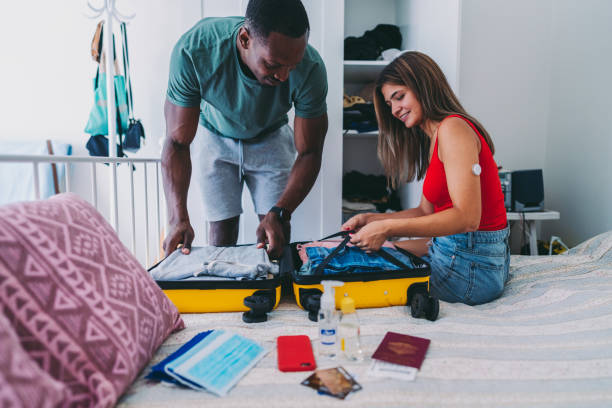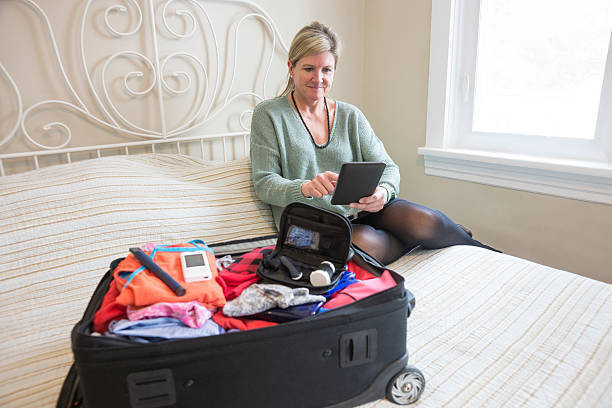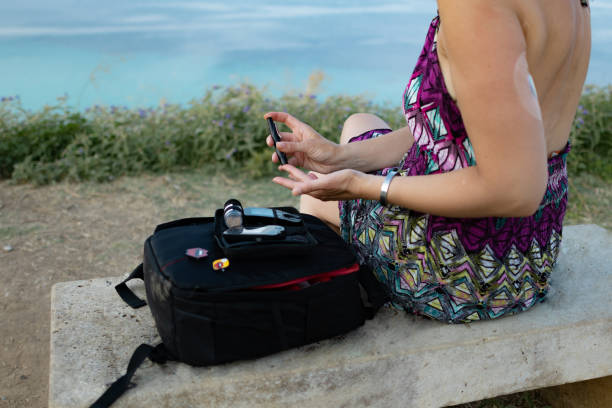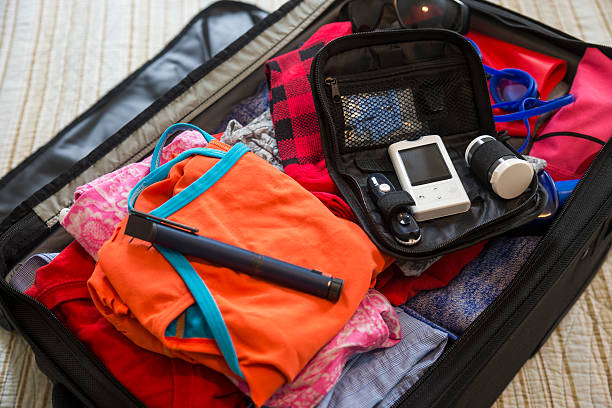Traveling is exciting, but if you have diabetes, it can also feel stressful. Long flights, time zone changes, and unpredictable meals can make blood sugar control harder. Changes in activity levels—like walking more on sightseeing days or sitting for hours during travel—can also affect your glucose. Even small details, such as airport delays or skipped meals, may throw off your routine.
The good news? With a little preparation, you can travel safely and enjoy every moment of your journey. By learning how to plan ahead, pack the right supplies, and make smart food choices, you’ll lower the risk of sudden highs and lows. This guide will show you step-by-step how to manage diabetes while traveling so you can stay healthy, confident, and stress-free on your next trip.
Why Travel Can Be Tricky with Diabetes
Travel changes your normal routine. You may eat at different times, sleep less, or walk more than usual. These shifts can affect your blood sugar levels and make it harder to stay balanced. Airplane food, road trip snacks, and foreign cuisines may also contain hidden sugars or carbs that you don’t expect. Even drinks like fruit juice, sweetened coffee, or alcohol can raise your levels quickly. On top of that, time zone changes can affect your medication schedule and make it tricky to know when to take insulin or pills. Stress, excitement, and jet lag may also play a role in how your body reacts.
But here’s the good news: with proper planning, you can avoid spikes and crashes. Whether you’re going on a weekend road trip or flying across the world, staying stable is possible. By packing smart, checking your blood sugar often, and being mindful about what you eat and drink, you can keep your energy steady and enjoy your trip without constant worry.

Preparing for Your Trip: Smart Planning Matters
Planning is the most important step when traveling with diabetes. A little preparation helps prevent emergencies and keeps you feeling your best.
1. Talk to Your Doctor Before Traveling
Schedule an appointment before your trip. Talking to your doctor gives you a chance to review your health and make a safe travel plan. Your provider can help you adjust your routine and prepare for the challenges that come with traveling. Ask your doctor about:
- Adjusting insulin for time zone changes – Crossing time zones can shift your meal and medication schedule. Your doctor can guide you on when to take your insulin so your blood sugar stays steady.
- Extra prescriptions in case of emergencies – Having a backup supply means you won’t run out of medication if your trip is delayed or your luggage is lost. Ask for written copies of prescriptions too, so you can refill them at a pharmacy abroad.
- Recommended vaccines or travel safety tips – Some destinations require vaccines or special health precautions. Your doctor can advise you on what’s needed and how to protect yourself while traveling.
For reliable travel health advice, you can also check the CDC’s travel page.
2. Pack a Diabetes Travel Kit
Having the right supplies ensures you’re ready for any situation. Pack your medications and equipment in your carry-on, not your checked luggage. Air travel delays and lost bags happen—keep your essentials with you.
Your kit should include:
- Blood glucose meter and test strips
- Continuous glucose monitor (CGM) supplies
- Insulin pens, vials, or pump supplies
- Syringes and pen needles
- Fast-acting glucose (like glucose tablets or gel)
- Healthy snacks (nuts, protein bars, whole fruit)
- Extra batteries or chargers for devices
- A doctor’s note and prescription copies
3. Wear Medical ID
Always carry a medical ID bracelet or card that states you have diabetes. This small step can make a big difference in your safety. In case of an emergency, it ensures medical staff knows what to do, even if you cannot speak for yourself. A medical ID can list important details such as your type of diabetes, the medications you use, and any allergies you may have.
Some people also include an emergency contact number. Wearing a bracelet, necklace, or keeping a card in your wallet gives doctors quick access to life-saving information. It’s one of the simplest ways to stay protected while traveling.

Flying with Diabetes: What You Need to Know
Air travel brings unique challenges for people with diabetes. Security checks, long flights, and meal schedules can make things complicated.
TSA Rules and Airport Security
According to the TSA, you can carry diabetes supplies through security. Inform the officer before screening. Insulin, needles, and liquid medications are allowed. Keep them in their original packaging.
In-Flight Tips for Blood Sugar Stability
- Check often: Air travel can cause dehydration, which may affect blood sugar. Test before, during, and after the flight.
- Stay hydrated: Drink water instead of soda or juice.
- Move around: Walk the aisle when possible to improve circulation.
- Pack your own food: Airline meals may be high in carbs and sugar. A healthy snack gives you more control.
Managing Diabetes Across Time Zones
Crossing time zones makes medication timing tricky. When your body clock shifts, your usual schedule for meals and insulin may no longer match the local time. This can lead to missed doses, double doses, or blood sugar swings if you don’t plan ahead.
- Prevention is key: Don’t wait until you feel unwell. Staying on schedule protects your energy and keeps your trip enjoyable.
- Eastward travel (shorter day): You may need less insulin because your day is shortened. Missing this adjustment could raise your risk of low blood sugar.
- Westward travel (longer day): You may need more insulin because your day is extended. Without a plan, your blood sugar may rise during long travel days.
- Check with your doctor: They can adjust your dosing plan based on the number of time zones you cross. Bring written instructions so you don’t forget.
- Use reminders: Set alarms on your phone or watch to keep track of medication times. This helps you stay consistent even if you feel tired or distracted.
Eating Healthy While Traveling
Food is one of the best parts of traveling. But unfamiliar meals can affect your blood sugar.
Smart Eating Strategies
- Stick to the plate method: Half veggies, one-quarter protein, one-quarter carbs.
- Read menus carefully: Ask about sauces, dressings, and hidden sugars.
- Choose whole foods: Grilled meats, fresh salads, and whole grains are safer than fried or processed foods.
- Limit alcohol: Alcohol can affect blood sugar and interact with medications.
Snack Ideas for Stable Blood Sugar
Always carry healthy snacks in case meals are delayed:
- Mixed nuts
- String cheese
- Whole fruit like apples or oranges
- Sugar-free protein bars
- Plain yogurt cups
Road Trips with Diabetes
Driving long hours comes with its own challenges. Unlike flying, you have more freedom with food choices, but sitting for too long can impact circulation and increase the risk of blood clots. Long drives may also throw off your meal schedule, leading to sudden drops or spikes in blood sugar if you’re not prepared. Staying alert behind the wheel is especially important, which means keeping your glucose levels steady throughout the trip.
Tips for road trips:
- Stop every 2–3 hours to stretch and move. Short breaks improve blood flow, reduce stiffness, and help keep your energy levels up.
- Keep a cooler with healthy snacks and water. Having options on hand prevents you from relying on fast food or convenience store meals.
- Avoid sugary gas station snacks. Chips, candy, and soda can cause quick spikes in blood sugar followed by crashes that leave you tired.
- Test blood sugar before driving. Low blood sugar can impair focus and slow reaction times, making driving dangerous. Always check before getting behind the wheel.
- Plan your route with food stops in mind. Knowing where you can find balanced meals helps you stay on track without stress.

Adventure and Outdoor Travel
Hiking, biking, or exploring nature is great exercise, but it also lowers blood sugar faster. Physical activity uses up energy quickly, and without careful monitoring, you may face sudden lows during outdoor adventures. The mix of exercise, fresh air, and sometimes unpredictable schedules makes preparation even more important. Staying safe means planning ahead while still enjoying the beauty of the outdoors.
Tips for outdoor travel with diabetes:
- Carry glucose tablets or gels in your pocket. These give you fast-acting carbs if your blood sugar drops while you’re on the trail or away from food.
- Wear comfortable shoes to prevent blisters. Protecting your feet is essential since diabetes can make healing slower. Good shoes and socks reduce the risk of injury.
- Let travel companions know about your condition. If you experience low blood sugar, friends or family will know how to help right away.
- Monitor blood sugar before and after activities. Checking your levels helps you spot patterns and adjust snacks or insulin for future adventures.
- Stay hydrated and pack balanced snacks. Water, nuts, and fruit can keep your energy stable during long hikes or bike rides.
What to Do in Case of Emergency
Even with preparation, emergencies can happen.
- Low blood sugar (hypoglycemia): Treat quickly with 15g of fast-acting carbs (juice, glucose tablets). Recheck in 15 minutes.
- High blood sugar (hyperglycemia): Stay hydrated and monitor ketones if possible. Seek medical help if symptoms worsen.
- Lost medication: Visit a local pharmacy with your prescription copies. In most countries, insulin is available.
For international emergencies, find nearby hospitals before your trip. The International Diabetes Federation offers resources worldwide.
Practical Travel Checklist for People with Diabetes
Here’s a quick checklist to review before leaving:
- Doctor’s appointment complete
- Extra prescriptions and supplies packed
- Medical ID ready
- Diabetes travel kit in carry-on
- Healthy snacks and water bottle
- Alarms set for medications
- Local hospital or pharmacy info saved
Final Thoughts: Travel with Confidence
Traveling with diabetes doesn’t have to be stressful. With smart planning, healthy food choices, and regular monitoring, you can keep your blood sugar stable and enjoy the adventure. Packing the right supplies, sticking to your medication schedule, and checking your levels often gives you confidence and peace of mind. When you prepare in advance, you spend less time worrying and more time enjoying the sights, food, and culture of your destination.
Remember: diabetes should never stop you from seeing the world. Stay prepared, stay mindful, and you’ll create lasting memories without compromising your health. Whether it’s a weekend road trip or a flight overseas, you have the tools to stay safe. Every trip is a chance to explore, connect, and live fully—your diabetes is just one part of the journey, not the limit.
Now it’s your turn: Have you traveled with diabetes before? What tips helped you the most? Share your experiences in the comments to help others travel with confidence.

